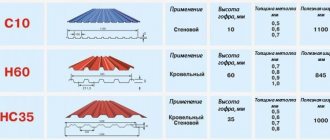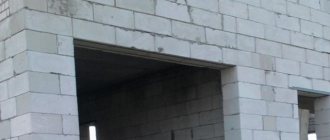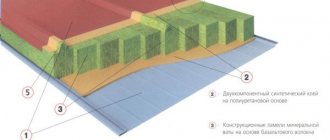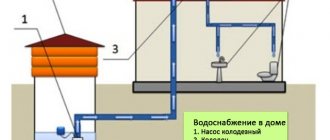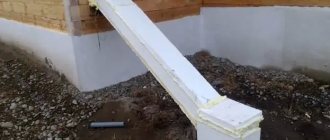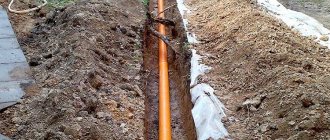Metal pipes
One of the main disadvantages of metal pipes is their excessive weight, which causes difficulties that arise during the transportation and installation of products. Pipe installation is carried out using permanent (welding or soldering) and detachable threaded connections. The use of a detachable connection simplifies further repairs of the system due to the ease of replacing damaged parts of the structure.
Using ordinary steel pipes in water supply is extremely unprofitable - this material has practically no resistance to corrosion, so the pipeline begins to rust. In addition to the fact that because of this, the system will begin to deteriorate at an accelerated pace, the water in the tap will also have a characteristic color and taste of rust.
When transporting water, steel pipes quickly begin to leak and lose their tightness, so they have to be replaced. Another negative factor associated with rust is plaque on the inner surface of the pipeline, which reduces its throughput. So it turns out that with high mechanical strength and heat resistance, it is undesirable to use steel pipes for arranging water supply systems.
Galvanized pipes for water supply are a completely different matter. The cost of such pipes is an order of magnitude higher than the cost of steel products, but it is clearly justified. The most important advantage of galvanized steel is its resistance to corrosion, which eliminates most of the disadvantages associated with this factor. However, a lot of weight is inherent in this type of pipe, so their installation cannot be called simple.
The best option for metal pipes for water supply is copper products. They are distinguished by a very high cost and a considerable number of advantages. The service life of copper pipes is quite high, as is safety (however, there is a nuance associated with the appearance of copper oxides, but this phenomenon does not occur in every case). Also, this material is characterized by the traditional complexity of installation for metal pipes - soldering copper pipes cannot be classified as a simple process.
Advantages and disadvantages of a combined and separate bathroom
AMETHYST - 02 M Residential building for up to 10 people or up to 2 cubic meters/day.
Aeration unit AS-1054 VO-90
Main table dispenser AquaPro 919H/RO (hot and cold water)
The main advantage of combining a toilet and a bathroom is the ease of wiring. In addition, due to the absence of a wall and one door frame, the useful area can be increased; a sink and even a washing machine can be placed.
There is also a minus, it is especially noticeable with a large family - it is difficult to take bath procedures for a long time when there is a line of people wanting to go to the toilet outside the door.
Plastic pipes for water supply
A modern alternative to metal products is plastic pipes, which have many advantages and disadvantages compared to their more traditional steel counterparts. In particular, polymer products are lightweight, simplifying transportation and installation, and have good performance characteristics and low cost.
There are two main types of plastic pipes used in plumbing:
- Polyethylene;
- Polypropylene.
It is worth considering both types in more detail.
Polyethylene pipes
One of the materials used for the manufacture of plastic pipes is cross-linked polyethylene, which, due to a special production technology, has increased strength characteristics without loss of flexibility and elasticity. There are also low-pressure HDPE pipes, but they are not very suitable for use in apartments.
Pipes made of cross-linked polyethylene are an excellent material for arranging cold and hot water supply in an apartment. This material can operate at temperatures of the transported medium up to +95 degrees, which is quite enough for water supply. Read also: “Which pipes are best for water supply – making the right choice.”
In addition, this value is not limiting - the destruction of polyethylene pipes begins only if the water temperature exceeds +110 degrees.
An important quality of polyethylene pipes is their plasticity. A water pipeline assembled from such pipes does not collapse even when frozen, which is especially important for private homes. In apartments, flexibility is more important, which allows you to give the pipeline the required shape.
Polypropylene pipes
If the budget allocated for construction is not too large, then polypropylene pipes would be a good option for arranging a water supply system. They are cheaper than other polymer products, and in some places they even surpass them in characteristics: the operating temperature of polypropylene is +95 degrees, and the pressure is up to 20 atmospheres. In addition, it is worth noting the service life, which on average is about 50 years. All that remains is to decide which polypropylene pipes are better in order to make the final choice.
The disadvantage of polypropylene products is the lack of plasticity, so installation of the pipeline at an angle is possible only with the help of appropriate fittings. Permanent connections of such pipes are made using a special soldering iron. In any case, before purchasing, you need to carefully understand which propylene pipes are best for water supply, and prepare the equipment necessary for installation.
Installation of different types of pipes
When you choose which pipes are best to use for water supply, it is important to consider the installation features.
Choosing plastic products provides a certain advantage - there is always a huge selection of fittings on sale. Threaded connections do not require enormous effort when tightening, so if necessary, a woman can replace any element. In addition, soldering (welding) of such products with permanent connections is not difficult and provides a high degree of tightness.
Making permanent connections of metal pipes will require the use of special equipment - welding machines or soldering kits in the case of copper products. Threaded connections require the use of seals.
Diameter of pipes for water supply in an apartment
The choice of pipes for water supply in an apartment is not limited to the choice of material for their manufacture - you also need to choose the right diameter of the products. The correct choice of pipe diameter will allow you to create a reliable and functional system (for more details: “How to choose the diameter of a pipe for a water supply system depending on the length of the system and its characteristics”).
Of course, increasing the diameter of the pipes also entails an increase in the cost of the system, while a pipeline that is too narrow will not have sufficient throughput. It would be best to find the “golden mean” and select pipes of the optimal diameter for a specific situation.
The diameter of the water supply system in an apartment must be calculated taking into account the initial pressure and the degree of its reduction along the entire length of the system. A regular pressure gauge is suitable for measuring inlet pressure, but even without one, you can get approximate values. For example, if in apartments three floors above the pressure is normal, then the input pressure is at least two atmospheres.
The change in pressure in the pipeline is influenced by:
- Number of different connections and fittings.
- Total length of the system.
- Availability and number of turns.
The pressure in the pipeline cannot be lower than 0.6 atmospheres, and the pressure, taking into account normal delivery to the farthest point of the system, must have a double reserve. If, taking these factors into account, 12 mm plastic pipes are installed, then the only result will be a guaranteed decrease in the performance of the system.
Pipes with a diameter of 16 mm are much better suited - they will be enough for normal operation of the water supply without loss of characteristics. To accurately calculate metal or metal-ceramic pipes for water supply, special formulas are used, but they are quite complex, so they are used only by specialists in this industry.
Pipeline layout in an apartment can easily be carried out according to the standard scheme:
- Pipes with a diameter of 1 or ¾ inches (25 and 20 mm) are most often used as risers.
- Direct piping is carried out using ½ or 3/8 inch (15 and 10 mm).
When choosing the diameter of water pipes for an apartment, you should consider the following points:
- The internal diameter of polypropylene pipes is not directly related to the external diameter (a half-inch pipe can have a clearance of 11 to 13 mm);
- Dimensions indicated in inches do not reflect the pipe capacity, which is especially important when arranging a pipeline that includes both metal and plastic elements;
- Before installing polypropylene pipes, you need to study the technology of their welding, for which you will need appropriate instructions.
The nuances of installing a water supply system
Knowing what water pipes are made of, you can get an idea about the installation features of each material:
- Plastic pipes are much more convenient and profitable. There are a considerable number of fittings for them, so the choice is quite extensive. Tightening the threaded connections in this case will not require serious effort, which greatly simplifies the work. The one-piece method of connecting pipes will ensure the tightness of the structure with minimal installation labor.
- To install a pipeline from metal parts, you will need special equipment: steel pipes are connected by welding, and for copper products you need soldering kits. If the connection is threaded, then it is imperative to use seals.
Conclusion
For water supply systems, you can use a variety of pipes, the choice of which directly depends on the operating conditions of the system and its features. There are metal and plastic pipes, the characteristics of which allow you to assemble any pipeline. When the question of what kind of pipe is needed for a water supply system is closed, all that remains is to choose the optimal pipe diameter for a specific situation.
Criteria for selecting materials for pipes
We would like to say right away that there are no good or bad pipes and the materials from which they are made. There are high-quality or low-quality pipes, respectively, as well as a good or bad manufacturer. Each type of pipeline product is convenient and optimal for its specific case, which is determined by the criteria or parameters of the heating system. After selecting the material for the pipes, a specific manufacturer is selected, and the service life of the system and the ease of its maintenance also depend on this.
The main parameters of heating and water supply systems by which materials for pipes are selected:
- liquid temperature (maximum and nominal)
- fluid pressure
- method of laying pipelines
- purpose (heating systems, heated floors, water supply)


